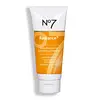What's inside
What's inside
 Key Ingredients
Key Ingredients

 Benefits
Benefits

 Concerns
Concerns

 Ingredients Side-by-side
Ingredients Side-by-side

Water
Skin ConditioningGlycerin
HumectantCocamidopropyl Betaine
CleansingSodium Laureth Sulfate
CleansingDecyl Glucoside
CleansingGlyceryl Oleate
EmollientCoco-Glucoside
CleansingPrunus Armeniaca Seed Powder
AbrasiveAcrylates/C10-30 Alkyl Acrylate Crosspolymer
Emulsion StabilisingPhenoxyethanol
PreservativeSodium Benzoate
MaskingSodium Chloride
MaskingPEG-40 Hydrogenated Castor Oil
EmulsifyingLimonene
PerfumingCitric Acid
Buffering3-O-Ethyl Ascorbic Acid
Skin ConditioningAnthemis Nobilis Flower Water
MaskingDipropylene Glycol
HumectantLinalool
PerfumingSodium Hydroxide
BufferingParfum
MaskingDisodium EDTA
Cocamidopropyl Dimethylamine
EmulsifyingBenzotriazolyl Dodecyl P-Cresol
UV AbsorberSodium Sulfate
Vaccinium Myrtillus Fruit Extract
Skin ConditioningSaccharum Officinarum Extract
MoisturisingPropylene Glycol
HumectantAlcohol Denat.
AntimicrobialCitrus Limon Fruit Extract
MaskingCitrus Aurantium Dulcis Fruit Extract
MaskingAlcohol
Antimicrobial1,2-Hexanediol
Skin ConditioningTris(Tetramethylhydroxypiperidinol)Citrate
StabilisingAcer Saccharum Extract
Skin ConditioningBiosaccharide Gum-4
Skin ConditioningTocopherol
AntioxidantBenzyl Alcohol
PerfumingDenatonium Benzoate
MaskingHydrogenated Palm Glycerides Citrate
EmollientDehydroacetic Acid
PreservativeCI 14700
Cosmetic ColorantCI 15985
Cosmetic ColorantWater, Glycerin, Cocamidopropyl Betaine, Sodium Laureth Sulfate, Decyl Glucoside, Glyceryl Oleate, Coco-Glucoside, Prunus Armeniaca Seed Powder, Acrylates/C10-30 Alkyl Acrylate Crosspolymer, Phenoxyethanol, Sodium Benzoate, Sodium Chloride, PEG-40 Hydrogenated Castor Oil, Limonene, Citric Acid, 3-O-Ethyl Ascorbic Acid, Anthemis Nobilis Flower Water, Dipropylene Glycol, Linalool, Sodium Hydroxide, Parfum, Disodium EDTA, Cocamidopropyl Dimethylamine, Benzotriazolyl Dodecyl P-Cresol, Sodium Sulfate, Vaccinium Myrtillus Fruit Extract, Saccharum Officinarum Extract, Propylene Glycol, Alcohol Denat., Citrus Limon Fruit Extract, Citrus Aurantium Dulcis Fruit Extract, Alcohol, 1,2-Hexanediol, Tris(Tetramethylhydroxypiperidinol)Citrate, Acer Saccharum Extract, Biosaccharide Gum-4, Tocopherol, Benzyl Alcohol, Denatonium Benzoate, Hydrogenated Palm Glycerides Citrate, Dehydroacetic Acid, CI 14700, CI 15985
Water
Skin ConditioningAlumina
AbrasiveGlycerin
HumectantParaffinum Liquidum
EmollientCaprylic/Capric Triglyceride
MaskingDimethicone
EmollientGlyceryl Stearate
EmollientPetrolatum
EmollientCetearyl Alcohol
EmollientPEG-100 Stearate
Phenoxyethanol
PreservativeSodium Polyacrylate
AbsorbentMethylparaben
PreservativeXanthan Gum
EmulsifyingPropylparaben
PreservativeTetrasodium EDTA
Ingredients Explained
These ingredients are found in both products.
Ingredients higher up in an ingredient list are typically present in a larger amount.
Glycerin is already naturally found in your skin. It helps moisturize and protect your skin.
A study from 2016 found glycerin to be more effective as a humectant than AHAs and hyaluronic acid.
As a humectant, it helps the skin stay hydrated by pulling moisture to your skin. The low molecular weight of glycerin allows it to pull moisture into the deeper layers of your skin.
Hydrated skin improves your skin barrier; Your skin barrier helps protect against irritants and bacteria.
Glycerin has also been found to have antimicrobial and antiviral properties. Due to these properties, glycerin is often used in wound and burn treatments.
In cosmetics, glycerin is usually derived from plants such as soybean or palm. However, it can also be sourced from animals, such as tallow or animal fat.
This ingredient is organic, colorless, odorless, and non-toxic.
Glycerin is the name for this ingredient in American English. British English uses Glycerol/Glycerine.
Learn more about GlycerinPhenoxyethanol is a preservative that has germicide, antimicrobial, and aromatic properties. Studies show that phenoxyethanol can prevent microbial growth. By itself, it has a scent that is similar to that of a rose.
It's often used in formulations along with Caprylyl Glycol to preserve the shelf life of products.
Water. It's the most common cosmetic ingredient of all. You'll usually see it at the top of ingredient lists, meaning that it makes up the largest part of the product.
So why is it so popular? Water most often acts as a solvent - this means that it helps dissolve other ingredients into the formulation.
You'll also recognize water as that liquid we all need to stay alive. If you see this, drink a glass of water. Stay hydrated!
Learn more about Water